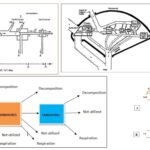AS and A Level Biology 33 Views 1 Answers
Sourav PanLv 9October 31, 2024
Explain that in non-cyclic photophosphorylation: • photosystem I (PSI) and photosystem II (PSII) are both involved • photoactivation of chlorophyll occurs • the oxygen-evolving complex catalyses the photolysis of water • ATP and reduced NADP are synthesised
Explain that in non-cyclic photophosphorylation: • photosystem I (PSI) and photosystem II (PSII) are both involved • photoactivation of chlorophyll occurs • the oxygen-evolving complex catalyses the photolysis of water • ATP and reduced NADP are synthesised
Please login to save the post
Please login to submit an answer.
Sourav PanLv 9May 15, 2025
Non-Cyclic Photophosphorylation: A Detailed Explanation
Overview:
Non-cyclic photophosphorylation is a light-dependent process in photosynthesis involving both Photosystem I (PSI) and Photosystem II (PSII). This process generates ATP and reduced NADP (NADPH), utilizing light energy, and releases oxygen (O2) as a byproduct.
Step-by-Step Explanation:
- Photoactivation of Chlorophyll:
- Light Absorption (PSII): Chlorophyll a molecules in Photosystem II (PSII) absorb light energy (approximately 680 nm).
- Excitation of Electrons (PSII): The absorbed light energy excites electrons in the chlorophyll molecules, elevating them to a higher energy state.
- Water Photolysis (PSII):
- Oxygen-Evolving Complex (OEC): The excited electrons in PSII are used to catalyze the photolysis of water (H2O), splitting it into:
- Protons (H+), which contribute to the proton gradient.
- Electrons, which reduce an electron acceptor.
- Oxygen (O2), released as a byproduct into the atmosphere.
- Oxygen-Evolving Complex (OEC): The excited electrons in PSII are used to catalyze the photolysis of water (H2O), splitting it into:
- Electron Transfer Chain:
- Electron Flow from PSII to PSI: The electrons from PSII are transferred through a series of electron carriers to Photosystem I (PSI).
- Light Absorption (PSI): Chlorophyll a molecules in PSI absorb light energy (approximately 700 nm), further exciting the electrons.
- Reduced NADP (NADPH) Synthesis:
- Final Electron Acceptor: The highly energized electrons from PSI reduce NADP+ to form NADPH.
- ATP Synthesis:
- Proton Gradient: The protons (H+) accumulated in the thylakoid lumen during electron transfer create a proton gradient.
- ATP Synthase: The energy from this gradient is utilized by ATP synthase to synthesize ATP from ADP + Pi.
Key Points:
- Both PSI and PSII Involved: Non-cyclic photophosphorylation requires the coordinated action of both Photosystem I and Photosystem II.
- Photoactivation of Chlorophyll: The process begins with the absorption of light by chlorophyll in PSII, initiating the electron transfer chain.
- Oxygen-Evolving Complex (OEC): Catalyzes the photolysis of water, releasing oxygen and protons.
- ATP and Reduced NADP Synthesis: The primary outcomes are the production of ATP and NADPH, essential for the Calvin Cycle (Light-Independent Reactions).
0
0 likes
- Share on Facebook
- Share on Twitter
- Share on LinkedIn
0 found this helpful out of 0 votes
Helpful: 0%
Helpful: 0%
Was this page helpful?




